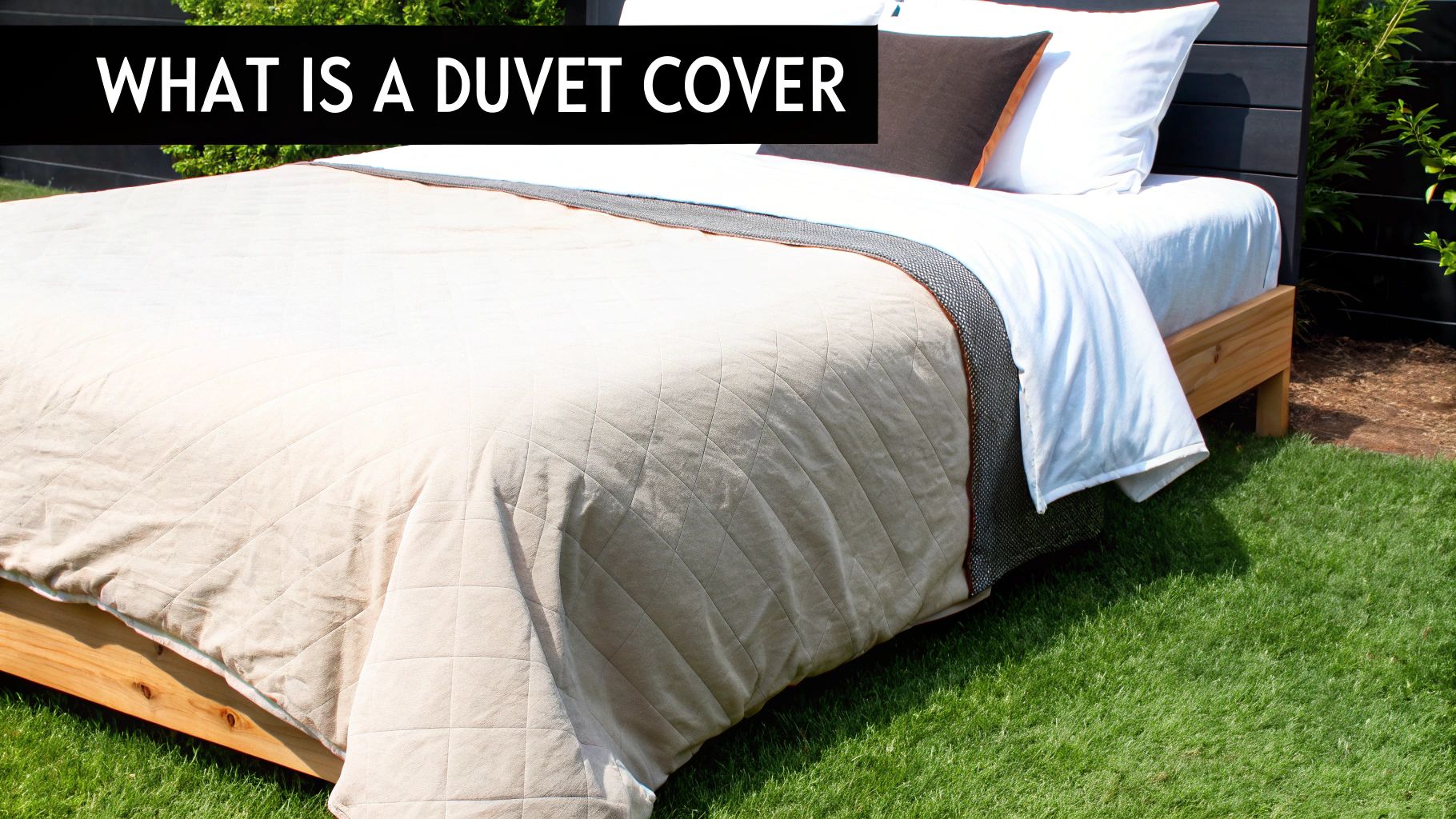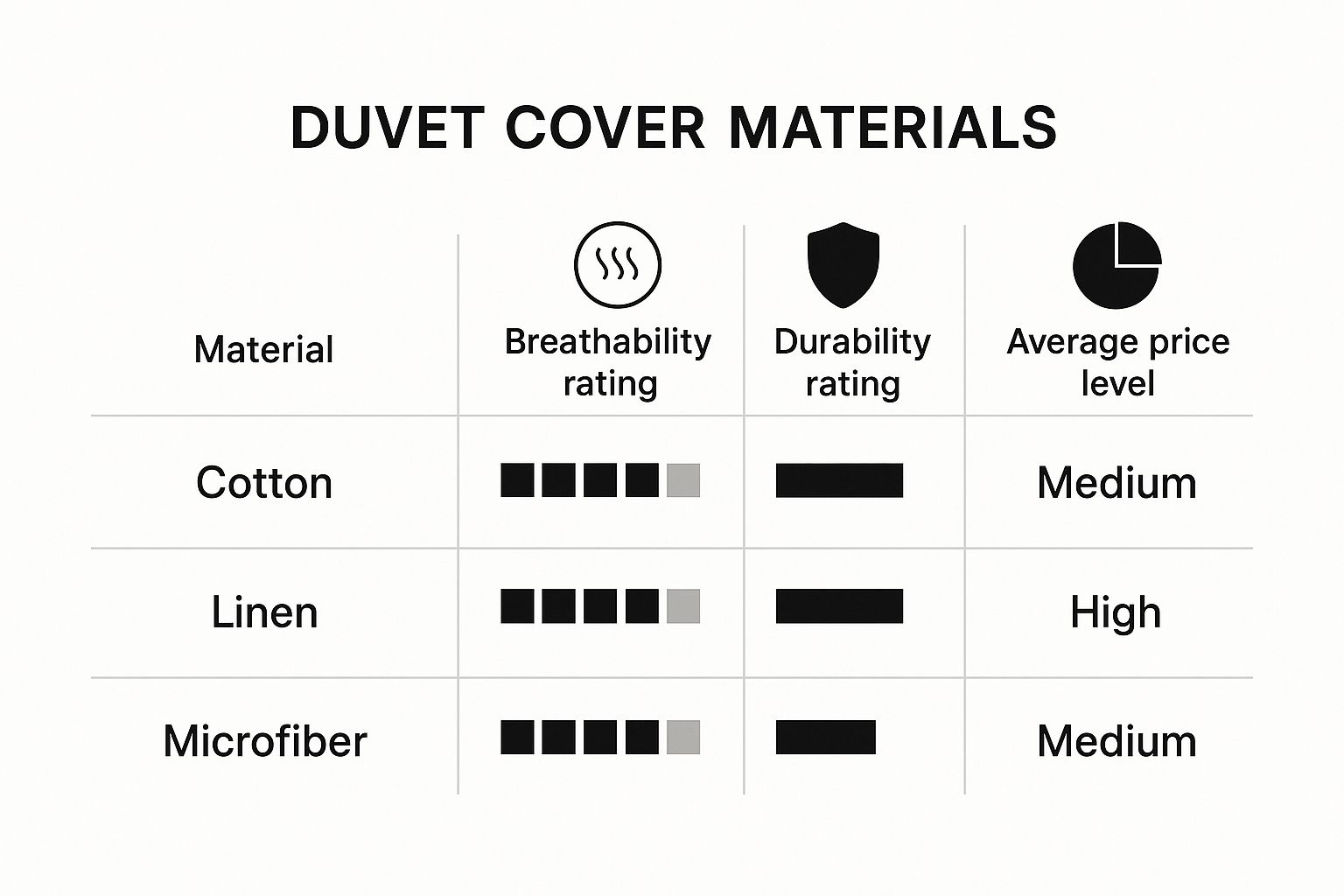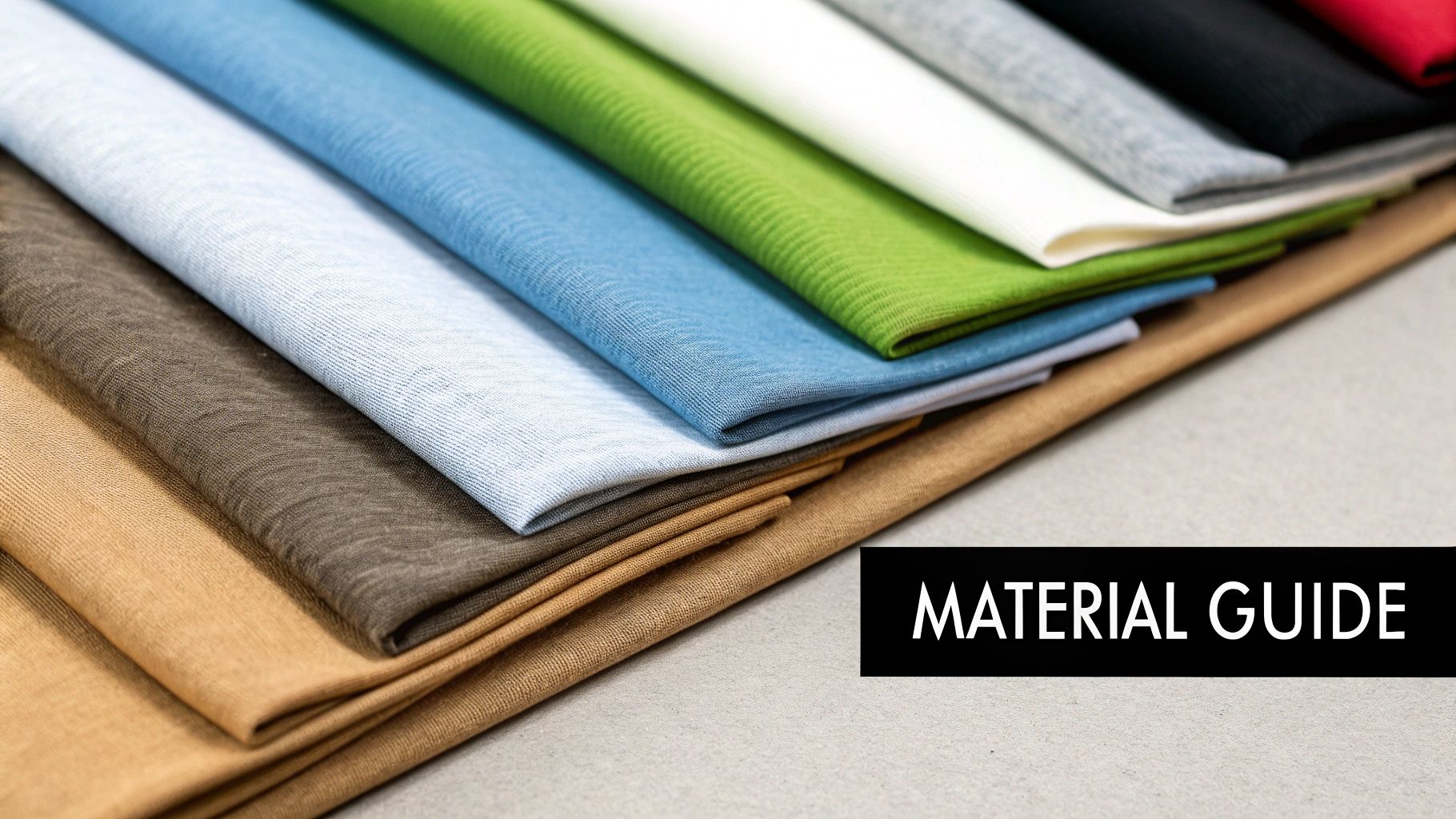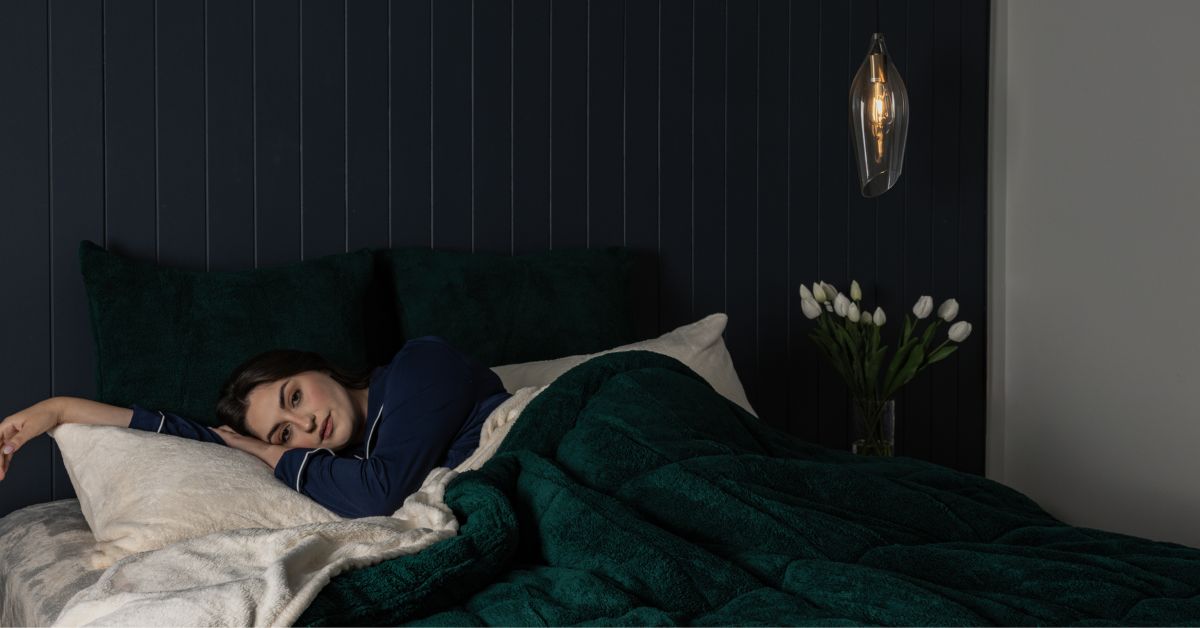Ever wondered what a duvet cover actually is? The simplest way to think of it is as a giant, decorative pillowcase for your duvet. It is one of those brilliantly simple inventions that makes life easier in two key ways: it keeps your duvet clean and lets you change your bedroom's style in a flash.
Your Quick Guide to Understanding Duvet Covers

A duvet cover is the perfect mix of practicality and personal flair. It is a removable layer that slips over your duvet, much like a dust jacket protects a good book. This simple design is what makes it so useful, making life a little bit easier and your bedroom a lot cosier.
First, it protects your duvet. The cover takes the brunt of daily life, think accidental coffee spills, dust, and natural oils from your skin. This is incredibly helpful because washing a lightweight cover is easy compared to the chore of cleaning a bulky duvet, which often needs a trip to the launderette.
Secondly, it is a brilliant decorating tool. If you fancy a change, just swap the cover. You can instantly refresh your room’s entire feel, whether you want to welcome a new season or you are just in the mood for a different look. It is all done without the expense of a full redecoration.
This clever blend of function and fashion has made the duvet cover a must,have in modern homes. It is no surprise that the UK bed linen market has seen strong growth, driven by our interest in home décor. For those interested in the numbers, you can explore more about bed linen market trends here.
To help you see the benefits clearly, here is a quick summary of what a duvet cover does for you.
Duvet Cover At a Glance
|
Feature |
Why It Matters to You |
|---|---|
|
Protective Barrier |
Shields your duvet from dirt, spills, and wear, helping it last longer. |
|
Easy Maintenance |
Machine,washable, making laundry day far simpler than cleaning a bulky duvet. |
|
Style Versatility |
Allows you to change your bedroom's look quickly and affordably. |
|
Comfort & Hygiene |
Easily washed to remove allergens and keep your sleeping space fresh. |
In short, a duvet cover is an elegant and practical solution for modern living. It makes it simple to protect your investment, streamline your cleaning routine, and express your personal style.
The Real Benefits of Using a Duvet Cover

It is one thing to know what a duvet cover is, but it is another to understand just how much of a difference it can make to your daily life. It is not just another piece of bedding. A good duvet cover offers a brilliant mix of hygiene, style, and pure common sense.
Think of it as the ultimate guardian for your duvet. It is the first line of defence against all the things life throws at your bed, such as spills, dust, sweat, and allergens. This simple barrier makes keeping your sleep space fresh and clean incredibly straightforward. Instead of wrestling with a bulky duvet, you just whip off the cover and pop it in the wash.
Effortless Style and Practical Savings
Changing your duvet cover is one of the quickest and most cost-effective ways to give your bedroom a fresh look. You can alter the room's atmosphere in minutes, embracing a new season or experimenting with a new color without the need for extensive redecorating. It functions like a wardrobe for your bed.
This practical approach also saves both time and money. Washing a lightweight cover is far easier than cleaning a bulky duvet, a task that often requires a visit to a professional cleaner.
A quality cover not only protects your duvet from spills and stains but also guards against the everyday wear and tear of regular use. This extends the life of your duvet, sparing you the cost of frequent replacements. It's a modest investment in preserving a more significant one.
Ultimately, a duvet cover allows your bedding to function more efficiently. You gain greater control over your home's hygiene and aesthetics, all while conserving time and money. For those seeking a plush, inviting bed, you can find additional tips on achieving the ideal fluffy white comforter to place inside your preferred cover.
-
Hygiene Excellence: The cover is easy to remove and can be machine-washed weekly, preventing allergens and germs from accumulating in your bed.
-
Instant Room Transformation: Switch out the cover to completely change your bedroom's look and ambiance in the time it takes to make the bed.
-
Cost-Effective Maintenance: Save on expensive professional cleaning and keep your duvet in excellent condition for years.
Choosing the Perfect Material for Your Comfort
The fabric of your duvet cover is what you feel against your skin throughout the night, so selecting the right material is crucial for a restful sleep. Different materials offer varied experiences; some keep you cool and fresh, while others provide the warmth you desire in winter. Let's explore the most common options to help you find your ideal match.
Duvet Cover vs. Comforter: A Comparison
When comparing a duvet cover with a comforter, it's important to note the distinctions in usage and maintenance:
-
Duvet Cover: Serves as a protective and decorative layer for a duvet insert. It is easy to remove and wash, making it a practical choice for those who wish to frequently change their bedding style or maintain high hygiene standards.
-
Comforter: A single-piece bedding item that combines both the filling and outer fabric. While it offers simplicity, it may not be as convenient to clean as a duvet cover, as washing the entire comforter can be cumbersome and may require professional cleaning services.
In conclusion, choosing between a duvet cover and a comforter depends on your personal preferences for maintenance, style flexibility, and ease of cleaning.
The Classics: Cotton and Linen
For good reason, cotton is often the top choice. It is wonderfully soft, breathable, and durable, making it a fantastic all,rounder for almost any home. It helps keep your body temperature stable, so you are not kicking the covers off one minute and pulling them back on the next.
Then there is linen. Famous for its effortlessly chic, slightly crumpled look, linen is a champion of breathability. It is incredibly airy and actually gets softer and more comfortable with every single wash. If you tend to get warm when you sleep or live somewhere with hot summers, linen is a game,changer for staying cool.
Modern Comforts: Microfibre and Bamboo
If your priorities are durability and easy care, microfibre is a strong contender. This synthetic material is impressively soft, resists wrinkles, and stands up well to regular washing, which is a real bonus for busy households or kids' rooms. It holds its colour beautifully and offers good warmth without feeling heavy.
For a touch of silky, eco,conscious luxury, bamboo is a fantastic option. It feels incredibly smooth, drapes beautifully, and is naturally hypoallergenic. Much like linen, it is brilliant at regulating temperature, making it another excellent choice for anyone with sensitive skin or who tends to overheat at night.
Comparing Common Duvet Cover Materials
To make the decision a little easier, here is a quick look at how these popular fabrics stack up.
|
Material |
Best For |
Feel & Texture |
Care Level |
|---|---|---|---|
|
Cotton |
Everyday comfort, families, all,season use |
Soft, crisp, and smooth |
Easy to Medium |
|
Linen |
Hot sleepers, warm climates, a relaxed look |
Naturally textured, airy, and gets softer over time |
Easy (embraces wrinkles) |
|
Microfibre |
Budget,conscious buyers, kids' rooms, low maintenance |
Ultra,soft, smooth, and lightweight |
Very Easy |
|
Bamboo |
Sensitive skin, eco,conscious shoppers, luxury feel |
Silky, smooth, with a slight sheen |
Medium (requires gentle care) |
Ultimately, the right fabric is the one that meets your personal needs for comfort, appearance, and practicality.

Finding Your Ideal Sleep Experience
Your choice of fabric really defines how your bed feels. It is no surprise that the UK's luxury bedding market continues to grow, as more of us are investing in high,quality materials that genuinely improve our sleep. This is not just about thread count, it is about the real comfort that materials like high,grade Egyptian cotton or pure linen can bring.
Think about what you truly want from your bedding. Do you crave that crisp, cool feeling of a hotel bed? Or is a soft, warm cocoon more your style? Do you need something that can survive weekly washes, or are you after a more delicate, luxurious touch?
By answering these questions, you can move beyond just picking a colour and find a duvet cover that feels tailor,made for you, turning your bed into a true sanctuary.
Finding the Right Size and Fastening

We have talked about materials, but getting the fit right is what really brings it all together. A cover that is too large will leave your duvet swimming inside, resulting in a baggy, untidy look. A cover that is too small will squash the duvet, making it feel lumpy and constricted.
To get that perfect, hotel,like finish, the secret is to measure your duvet before you buy a cover. Do not just rely on the label, as a ‘King’ in one country is not always the same as a ‘King’ elsewhere. Taking a quick measurement of the length and width is the surest way to get a cover that fits like a glove.
If you need a hand with specific dimensions, our comforter size guide breaks down all the common sizes.
Understanding Fastening Options
Once you have sorted the size, the next thing to consider is how the cover closes. It might seem like a small detail, but the type of fastening affects both the look of your bed and how easy it is to change your sheets.
-
Buttons: A timeless classic. Buttons provide a really secure closure and add a touch of traditional, decorative charm to your bedding.
-
Poppers (Press Studs): If you dread laundry day, poppers are your best friend. They snap together in a flash, making the job of changing your duvet cover quick and painless.
-
Zips: For a completely clean and seamless look, nothing beats a zip. It tucks the duvet away neatly, leaving no gaps for a sleek, modern finish.
The best fastening comes down to what you value most. Is it the traditional look of buttons, the sheer convenience of poppers, or the minimalist finish of a zip?
Paying attention to both the size and the fastening ensures your duvet cover is not just a pretty addition. It becomes a practical, perfectly fitting part of your bed that looks fantastic and works for you.
How to Care for Your Duvet Cover
Keeping your duvet cover looking and feeling brand new is actually quite straightforward. With a few simple habits, you can protect its colour, softness, and shape for years, making sure your investment pays off in countless nights of comfort.
First things first, always check the care label. Different materials require different approaches, so this is your golden rule. As a general guide, always turn your duvet cover inside out before it goes into the machine. It is a simple trick, but it does wonders to protect the outer fabric and any detailing from the rough and tumble of a wash cycle.
Washing and Drying Tips
For most common materials like cotton or microfibre, a gentle wash with similar colours is all you need to keep your sleeping space fresh and hygienic.
-
Washing: Stick to a mild detergent and steer clear of harsh chemicals like bleach. Bleach can be tempting for whites but will weaken the fabric’s fibres over time.
-
Drying: If you have the space, line drying is brilliant. It is gentle on the fabric, eco,friendly, and leaves your bedding with an unbeatable fresh scent. If you are using a machine, just be sure to choose a low heat setting on your tumble dryer to prevent shrinkage and keep it feeling soft.
Caring for your bedding properly is not just about cleanliness, it is about making it last. Following these simple steps extends the life of your cover, turning it into a more sustainable choice for your home.
This mindset is becoming more common, as people are now actively looking for high,quality textiles with features like hypoallergenic or sustainable fabrics. You can see how technology is influencing this shift across the duvet cover market here. For more detailed advice, our snuggle comforter care guide has some extra tips that you might find useful.
Finally, a quick word on storage. Before you put it away, make absolutely sure your cover is completely dry. Fold it neatly and store it in a cool, dry spot, like a linen cupboard, away from direct sunlight to stop the colours from fading.
Got Questions About Duvet Covers? We Have Answers.
Having covered the fundamentals, let's address some frequent inquiries. These concise responses should resolve any lingering doubts, ensuring you select and use your new bedding with complete assurance.
How Often Should I Wash My Duvet Cover?
Generally, it is recommended to wash your duvet cover every one to two weeks.
If you share your bed with pets, have allergies, or tend to get warm at night, a weekly wash is advisable. This routine keeps your sleeping environment fresh by removing dust mites, allergens, and skin cells. One advantage of using a duvet cover is that the actual duvet requires deep cleaning only a few times a year.
What's the Deal with Thread Count? Does It Actually Matter?
Thread count refers to the number of threads woven into one square inch of fabric. While a higher count can suggest a softer, more durable material, it is not the sole factor. Sometimes, it is more of a marketing tactic.
The quality of the fibre is far more crucial. For instance, a 300 thread count cover made from high-quality, long-staple cotton will feel significantly better and last longer than a 1,000 thread count sheet made from inferior, short fibres. My advice? Focus on the material, like pure linen or premium cotton, rather than numbers.
The best measure of quality isn't numerical; it's how the fabric feels against your skin. An excellent duvet cover should be soft, breathable, and align with your personal comfort preferences.
Can I Use a Duvet Cover Without the Duvet?
Certainly! On warm summer nights, a duvet cover serves well as a lightweight top sheet or blanket.
This provides just enough coverage to ensure comfort without the insulating warmth of the duvet insert. It is a smart way to maintain a stylish bed throughout the year while easily adjusting to temperature changes.
Is There an Easy Way to Put on a Duvet Cover?
Yes, and it is a complete game-changer. The 'burrito' or 'sushi roll' method simplifies the process.
Here’s how:
-
Turn your duvet cover inside out and lay it flat on the bed, with the opening at the foot.
-
Position your duvet directly on top, aligning all four corners.
-
Starting from the head of the bed, tightly roll both the cover and duvet together, like a burrito.
-
Once rolled, tuck the opening of the cover around the ends of the roll, enclosing it.
-
Unroll it back towards the head of the bed. Your duvet will be perfectly in place.
Why Choose a Comforter Over a Duvet Cover?
What are the benefits of using a comforter instead of a duvet cover?
Comforters are a convenient choice as they are often sold as part of a set with matching bed linens, providing an easy, coordinated look for your bedroom. Additionally, comforters are typically less complicated to manage, offering the simplicity of a one-piece option without the need for inserting or changing covers.
Why might someone prefer a comforter for a child's bed?
For children's rooms, comforters can be more practical due to their ease of cleaning and straightforward usage. They eliminate the need to wrestle with covers, making them a low-maintenance option for busy parents.
Ready to feel the difference? Explore the beautiful and practical range of bedding at Morgan and Reid. Find your perfect match and transform your sleep at https://www.morganandreid.com.



Share:
Funky Bed Comforters: A Guide to Stylish Bedrooms
Finding Your Perfect Beige Comforter